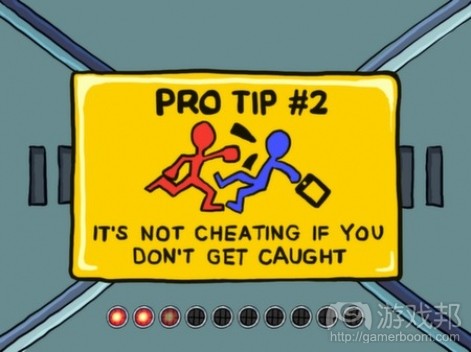分享向人们公开展示游戏的5个经验
在数周前我将自己的最新项目拿到Full Indie UK的首个游戏展(由Vristol Games Hub举办),这款名为《Tap Happy Sabotage》的游戏是针对Windows 8的大型触屏所设计。
在此之前我还开发过《Slamjet Stadium》以及《Greedy Bankers vs The World》等允许玩家进行实体碰撞,鼓励他们作弊的游戏。这些游戏都因为获得了大量朋友的试玩而实现不少收获。
这个过程让我获得了不少关于社交玩法的经验。例如玩家何时开始变得富有竞争性?他们在哪个地方会不知所措和迷惑,原因如何?游戏的哪个环节最具吸引力,人们会讨论什么内容?
1.成为优秀的主持人
我通常会扮演主持人的角色,提供足够的解释让人们开始游戏,但会在必要的时候快速退出。理想情况下的玩家会自己解决问题——我会发现自己需要介入和解决的情况,所以我可以在UI中更好的传达信息。
但作为主持人我还得营造一种游戏氛围。这种做法有助于我在最后阶段更好地设计UI。
例如,作弊,连推带挤是我大部分工作的中心环节。但对许多玩家来说,如果你不鼓励他们,告诉他们可以做什么,或者让他们看到其他玩家作弊(并意识到这是可以接受的行为),他们就不会有这种举动。
在《Slamjet Stadium》这款游戏中,我使用加载屏幕提示人们可以作弊的方法,以便他们在玩游戏之前知晓作弊机制。在《Greedy Bankers》中,偷窃宝石可以获得点数奖励——如果游戏机制鼓励你去做,那它必定就是游戏精神所在!
2.保持竞争性
仅仅观看玩家的表情和肢体语言就可以让你明白,玩家何时“理解”了游戏。在试玩《Slamjet Stadium》beta版本的时候,我发现玩家在实现首个目标时会迅速变得极具竞争性。
即便他们只是侥幸得分,也会获得一种精通戌,并且会通过获得更多得分来刺激竞争对手。
在游戏中心测试可容纳7人玩家的《Tap Happy Sabotage》时,有名设计师注意到,有些玩家如果在开场回合没有得分,他们就会放弃游戏。
在最后一个版本中,我权衡了一下游戏,让所有人都无法在首轮获胜,直到所有人都得分为止。让所有人都觉得自己得分了,可以保持所有玩家的积极和参与心态。
3.让人们尽情游戏
你可能会惊讶地发现当你让玩家打破规则时,他们究竟有多实际。即使是完全的陌生人也会抓住他人的手臂来获胜——大型群体中更是如此。
在《Greedy Bankers vs The World》中,桌面的中央是最具有价值的控制部分,因为将你对手的宝石移动到自己的一边可以增加其价值。在一些样本中,游戏会转变成一场摔跤大赛,因为玩家双方都试图控制局势。虽然看起来很有趣,但它也可能陷入打破心流状态的僵局,并且也有造成玩家人身伤害的风险。
这里有个教训:永远不要让焦点过长时间居于同一位置。在《Tap Happy Sabotage》中,我确保玩家的纸牌遍布整个屏幕,这样即便玩家陷入混乱状态,也不至于被拴在同一个地点上。
4.摆脱屏幕局限性
当有7名玩家共享一个控制空间时,你不应该寄希望于精细的控制方式,通常你会想保持屏幕的整洁性,以便人人都能看到屏幕上发生的情况。我所测试的最成功的游戏机制并不在于控制和战略,而是现实世界的能力。
在《Tap Happy Sabotage》中,观察发挥着很关键的作用,那些最先看到自己纸牌的人通常可以得到更多分数。这样他们反应速度更快,并且能够以有趣的方法混淆对手的视听。
这样技能是非常通俗易用的,无论你对硬件有多熟悉。即便你从未玩过这款游戏,也能通过观察他人玩法迅速理解游戏。这在公共场所更易于吸引人们加入游戏。
5.注意观察
测试游戏玩法可能已经是你设计过程的一个核心,但将你的游戏带到不受控制的环境和公共场合中还要注意一些经验。你可以从观察人们眼睛何时发亮,谁最快融入游戏,导致玩家邀请好友参与的原因中获得许多信息。
实体多人游戏的经验也适用于其他游戏类型。最初的积极感正是《愤怒的小鸟》和《Candy Crush Saga》等休闲游戏成功的关键。
将你的游戏带到人们面前吧,试试玩家的积极性如何,你将从中学到宝贵的经验。(本文为游戏邦/gamerboom.com编译,拒绝任何不保留版权的转载,如需转载请联系:游戏邦)
Public play: 5 lessons learned from taking games out and about
By Guest Author
Just a few weeks ago I took my latest project to Full Indie UK’s first games showcase event, hosted by the Bristol Games Hub. The game, Tap Happy Sabotage, is a party game designed for large-scale touch-screen monitors on Windows 8.
This isn’t the first touchscreen party game I’ve taken on the road. Tap Happy Sabotage follows Slamjet Stadium and Greedy Bankers vs The World in allowing players to physically collide, and encouraging them to cheat. They’ve all benefited from being tried out by excitable groups of friends.
The process teaches me a lot about what goes into social play. When do players get buzzed and competitive? Where do they get lost and confused, and why? Which sections are the most photogenic, which ones draw a crowd, and what do people go away talking about?
1 Be a good host
I tend to take on the role of compère at demos, providing enough explanation to get people started, but dropping out as quickly as is feasible. Ideally players should work things out for themselves – anything I need to step in and explain I take note of, so I can convey it better in the UI.
But as compère I also build the spirit and tone of play. Noting what I need to do to build this spirit helps me design the UI to do this job for me in the final release.
For example, cheating, pushing and shoving are central to much of my work. But for many players, they won’t start doing this unless prompted – by being told they can do it, or seeing another player cheat, it becomes socially acceptable.
In Slamjet Stadium, I use the loading screens to suggest ways people could cheat, so that before they even play the game they know that cheating is intended. In Greedy Bankers, stealing gems is rewarded with a points bonus – if the mechanics encourage you to do it, it must be in the spirit of the game!
2 Keep it competitive
Simply watching players’ expressions and body language will tell you when players have “got” the game. When trialling the beta of Slamjet Stadium, players would immediately become hotly competitive when they scored their first goal.
Even if it was just dumb luck, they felt a sense of mastery and were usually keen to rub this in their opponent’s face by scoring some more.
While testing seven-player Tap Happy Sabotage at the games hub, a fellow designer noticed that some players gave up if they could not score a point in the opening rounds.
In the latest build I now weight the game so that no-one can win the first round until everyone has scored a point. By making everyone feel like they can score keeps all players positive and involved.
3 Let people play dirty
You’ll be surprised at just how physical players become when you let them break the rules. Even complete strangers end up grabbing each other’s arms to win – increasingly so with large groups.
In Greedy Bankers vs The World, the centre of the board is the most valuable part of the board to control, as moving a gem from your opponent’s side to your own doubles its value. In some demos the game would devolve into a wrestling match as both players tried to dominate this space. While very funny to watch, it also was a flow-breaking stalemate, and a risk of injury.
There’s a lesson here: never have a focal point in the same place for too long. In Tap Happy Sabotage I made sure players’ cards are distributed all over the screen, so that even if players get tangled up reaching for them, it never turns into a bundle over the same point.
4 Bring it outside the screen
When seven players share a single control space you should not expect nuanced control, and often you’ll want to keep the screen clear of hands so that everyone can see what’s going on. The most successful mechanics of the games I’ve road tested are not in control and strategy, but in real-world abilities.
Observation plays a key role in Tap Happy Sabotage, as points often go to those who spot their card first. So does reaction speed, and the imagination to mess up your opponents in entertaining ways.
These skills are universally accessible regardless of your familiarity with the hardware. Even if you’ve never played the game before you can watch others and understand it quickly. At public events this makes it easier to coax people into joining in.
5 Pay attention
Playtesting your games is probably core to your design process already, but there are important lessons in bringing your game out of a controlled environment and into a public space. There is so much to be learned from watching when people’s eyes light up, who gets involved quickest, and what causes them to invite friends to join in.
The lessons of physical multiplayer games are applicable to other games too. The initial sense of positivity and success is key to casual behemoths from Angry Birds to Candy Crush Saga.
Gameplay that is readable to those who don’t understand the systems is necessary to make a game successful in Let’s Play videos: today’s cultural barometer of core gaming.
So take your game out into the world, and test how well it gets players motivated. The lessons you’ll learn will be invaluable.(source:pocketgamer)
上一篇:关于《我的世界》开发者的个人故事
下一篇:列举各时代的独立游戏经典之作










































 闽公网安备35020302001549号
闽公网安备35020302001549号